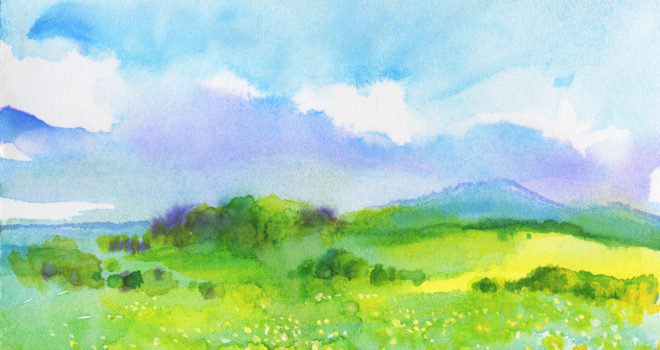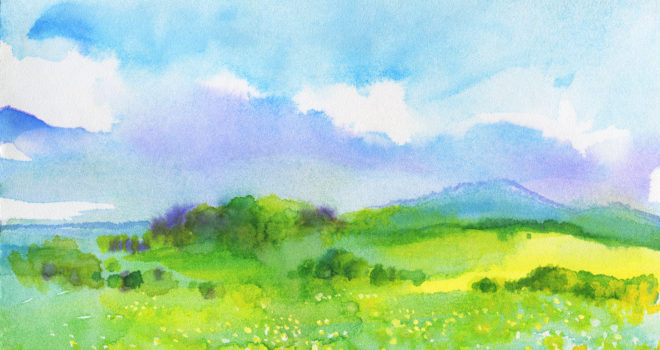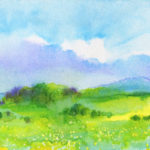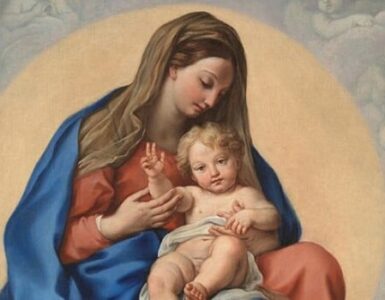Around five and a half years ago, I began learning how to draw. I had always been convinced that I couldn’t draw, and the reasons for never attempting it are too complicated to go into here. But, pregnant and mostly bedridden with hyperemesis gravidarum, I needed something to do that would soothe my suffering heart.
And so, I began to sketch and watercolor. There was nothing very impressive about those early pieces, but they were the beginning of a journey that I am still on – a journey in which I have found myself seeking God.
For years now, I have been healing from painful experiences in my early life – working towards forgiveness of others and healing for myself. Anyone who has ever undergone this sort of healing process knows how long and painful it is – years of working with therapists, spiritual directors, confessors, and friends. I have been so blessed by the people who have helped me work through and treat my own pain and trauma.
But one of the greatest ways that God has led me to healing has been through my sketchbook.
Rooted in Reality
When traumatic experiences occur in early life, it often results in complex trauma, and can lead to adults who are adept at disassociation. This means that although they are living in their current circumstances, they do not feel connected to their surroundings. They feel numb. It was a survival tactic that allowed them to survive previous trauma, but it no longer serves the person when the trauma has ended.
Disassociation is not limited to complex trauma or PTSD – people with anxiety or depression can also experience similar symptoms. And, as anyone who has sought treatment for any of these mental health conditions knows, it is important to learn how to be rooted in reality.
This is, incidentally, an idea that is beautifully compatible with and relevant to our Catholic faith. The saints are those who are most rooted in reality – they are rooted in God who is more real than anyone or anything else. But they are also rooted in the reality of the Incarnation – in the goodness of the physical creation and the bodies that God has given us. Dissociation makes that sort of rest hard, and healing can make it possible.
There are many ways that someone struggling with this can draw themselves more fully into being present in their current circumstances, but the one that I have found to be most effective is painting.
A couple of years ago, I took up the practice of plein air painting, that is painting outdoors, on location. My anxiety had been heightened for as long as I could remember, but whenever I began to paint, I felt peace wash over me. Painting – looking for and trying to depict color, shadow, composition, value – made me able to settle into my current circumstances, rooted in the physical reality of the beauty of God’s creation. And, as I was lost in this process of painting, I found myself more open to God. I began to feel deep peace, and an openness to the beauty of God’s creation. I wasn’t fleeing the present circumstance – I was embracing it, living in it, allowed myself to be messy in the midst of it (because there is truly no “neat” way to oil paint).
Drawn Into Wonder and Awe
One of the seven gifts of the Holy Spirit is the gift of “Wonder and Awe,” and the Holy Spirit has drawn out that gift in me (given at my Confirmation) in the course of my painting and development as an artist. I have often seen beauty in nature, and it has often drawn my heart to him, from childhood.
But there is a difference in seeing the world at first glance and seeing it as an artist. An artist must train her or his eye to not look for what they think they see (as our minds will often fill in the gaps of what we see based on assumptions of how something should look) but rather to see things as they are. When I first began painting, I tried to figure out what the colors of something should be, and I painted them. My trees were always green. My shadows were always black or gray.
As I continued to paint, I learned about value – how dark or light is the shade of a given color? I learned about cool and warm colors – shadows are often cool versions of the surrounding color, and often feature blends that include blues. I learned (and am still learning) how to paint shapes and light, not things in order to make my paintings look realistic. And in learning all of this, I began to truly see the world around me.
As I drove around, I would notice colors and mentally try to figure out what they were. (Did that green look tinted with an ultramarine blue? Were those leaves a sap green? Or did they have some cadmium yellow mixed in?) Then, I found myself trying to mentally do value sketches – where were the darkest values? Were the distant hills a middle value or a light value?
If I had my paints, I would try to use that information to make a piece in my sketchbook. If I didn’t have my paints, I would try to remember that information and paint it later.
But each time, no matter how hard I tried, it would never look exactly like what I was seeing. And as I marveled at the color, the light, the values, the perfection of it all, I found myself growing in Wonder and Awe of God.
This, too, has become part of my healing – to seek and find beauty, to rest in it, but to know that it is not something that I can conjure on my own. Rather, that beauty and that peace can come only from the goodness of God and resting in it requires profound trust.
The Artist
God is an artist. The beauty of nature, of humans, of animals is more complex or beautiful than any other artist could ever come up with. Yet, a good artist will not feel jealousy but rather wonder in the face of the art of another.
In the case of God’s work of art, though, the viewer is not removed from it. We are a part of the masterpiece that he is creating.
No matter what pain or suffering has been a part of your past, God can work it into his masterpiece. You are his masterpiece. No part of you is irredeemable. And this story of your life that he is painting possesses a beauty that only he, the artist, can see mid-painting. Every painting has an “ugly stage” – a stage where any onlooker would think it was a mistake and utterly lacking in beauty. Yet, the artist knows this to be a necessary part of the process. What appears ugly to the onlooker, the artist knows to be an important part of the beauty of the final piece.
Rest in hope – you are God’s masterpiece, and he is not finished with you, yet.












